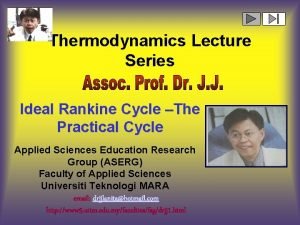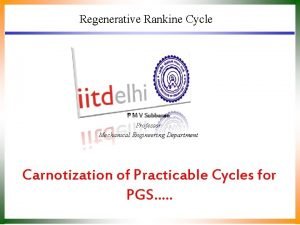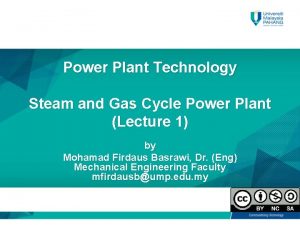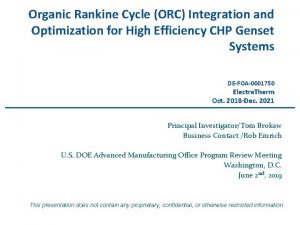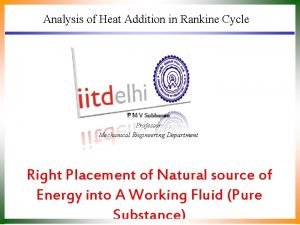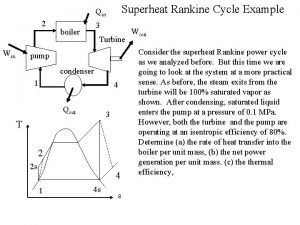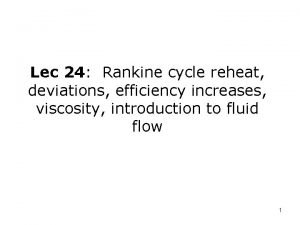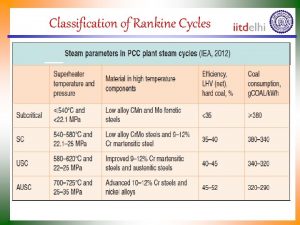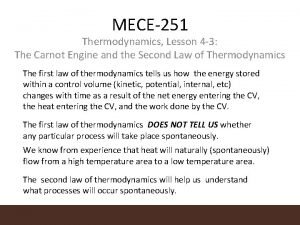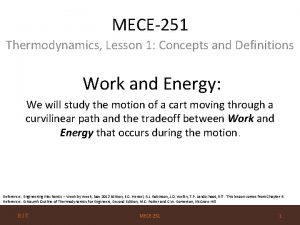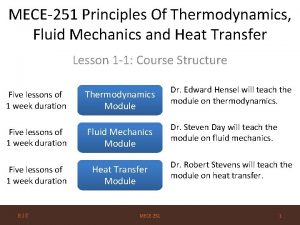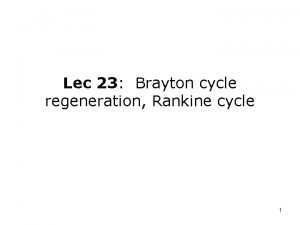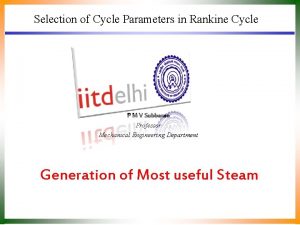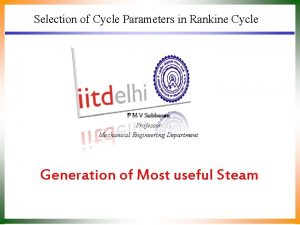MECE251 Thermodynamics Lesson 5 3 The Rankine Cycle









- Slides: 9

MECE-251 Thermodynamics, Lesson 5 -3: The Rankine Cycle (Vapor Power Cycle aka Steam Cycle) ►Our national power demand has challenges related to ►Declining economically recoverable supplies of nonrenewable energy resources. ►Effects of global climate change and other environmental and human health and safety issues. ►Rapidly increasing demand for power owing to increasing population. ► We are heavily dependent on coal, natural gas, and nuclear power. Reference: Moran, Shapiro, Boettner, Bailey: Fundamentals of Engineering Thermodynamics, 7 th Edition, Dec 2010, © 2011, Wiley.

Introducing Power Generation ► The Rankine Vapor Power Cycle plays an important role in much of the large scale energy production in the USA and around the world. Reference: Moran, Shapiro, Boettner, Bailey: Fundamentals of Engineering Thermodynamics, 7 th Edition, Dec 2010, © 2011, Wiley.

Introducing Vapor Power Plants ►In fossil-fueled plants, the energy required to vaporize liquid water into steam originates in combustion of the fuel. Reference: Moran, Shapiro, Boettner, Bailey: Fundamentals of Engineering Thermodynamics, 7 th Edition, Dec 2010, © 2011, Wiley.

Introducing Vapor Power Plants ►In nuclear plants, the energy required to vaporize liquid water into steam originates in a controlled nuclear reaction. Reference: Moran, Shapiro, Boettner, Bailey: Fundamentals of Engineering Thermodynamics, 7 th Edition, Dec 2010, © 2011, Wiley.

Power Cycle Review ►The first law of thermodynamics requires the net work developed by a system undergoing a power cycle to equal the net energy added by heat transfer to the system: ∙ ∙ Wcycle = Qin – Qout ►The thermal efficiency of a power cycle is ∙ ∙ Reference: Moran, Shapiro, Boettner, Bailey: Fundamentals of Engineering Thermodynamics, 7 th Edition, Dec 2010, © 2011, Wiley.

The Rankine Cycle ►Each unit of mass of water circulating through the power plant undergoes a thermodynamic cycle known as the Rankine cycle. ►The four principal control volumes involve these components: ►Turbine ►Condenser ►Pump ►Boiler All energy transfers by work and heat are taken as positive in the directions of the arrows on the schematic and energy balances are written accordingly. Reference: Moran, Shapiro, Boettner, Bailey: Fundamentals of Engineering Thermodynamics, 7 th Edition, Dec 2010, © 2011, Wiley.

The Rankine Cycle ►Applying mass and energy rate balances Turbine Condenser Pump Boiler Reference: Moran, Shapiro, Boettner, Bailey: Fundamentals of Engineering Thermodynamics, 7 th Edition, Dec 2010, © 2011, Wiley.

The Rankine Cycle ►Performance parameters Thermal Efficiency Back Work Ratio The back work ratio is characteristically low for vapor power plants. Reference: Moran, Shapiro, Boettner, Bailey: Fundamentals of Engineering Thermodynamics, 7 th Edition, Dec 2010, © 2011, Wiley.

Ideal Rankine Cycle ►The ideal Rankine cycle consists of four internally reversible processes: Process 1 -2: Isentropic expansion through the turbine Process 2 -3: Heat transfer from the working fluid passing through the condenser at constant pressure Process 3 -4: Isentropic compression in the pump Process 4 -1: Heat transfer to the working fluid passing through the boiler at constant pressure Variations of this cycle include: turbine inlet state is superheated vapor, State 1′; pump inlet, State 3, falls in the liquid region. Reference: Moran, Shapiro, Boettner, Bailey: Fundamentals of Engineering Thermodynamics, 7 th Edition, Dec 2010, © 2011, Wiley.
